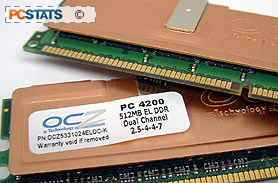 Unreal Tournament 2003 Unreal Tournament 2003 |
Source: Epic |
|
Unreal Tournament 2003 is the sequel to 1999's
multiple 'Game of the Year' award winner. It uses the very latest Unreal Engine
technology - where graphics, sound and gameplay are
taken beyond the bleeding edge. Unreal Tournament 2003 employs the use of Vertex
as well as Pixel Shaders and it's recommended that you use a DirectX 8 videocard
to get the most out of the game.
| UT2003 640x480 Flyby
|
|
AMD (FSB/Memory)
|
FPS |
Ranking |
| 1. |
2x 512MB OCZ EL PC4200
(200/400 MHz) |
240.37 |
 |
| 2. |
2x 512MB OCZ EL PC4200 (214/428 MHz) |
246.51 |
 |
|
Intel
(FSB/Memory) |
|
|
| 1. |
2x 512MB OCZ EL PC4200
(200/400 MHz) |
201.28 |
 |
| 2. |
2x 512MB OCZ EL PC4200 (271/542 MHz) |
271.35 |
 |
| UT2003 640x480
Botmatch |
|
AMD (FSB/Memory) |
FPS |
Ranking |
| 1. |
2x 512MB OCZ EL PC4200
(200/400 MHz) |
78.76 |
 |
| 2. |
2x 512MB OCZ EL PC4200 (214/428 MHz) |
80.94 |
 |
|
Intel
(FSB/Memory) |
|
|
| 1. |
2x 512MB OCZ EL PC4200
(200/400 MHz) |
67.2 |
 |
| 2. |
2x 512MB OCZ EL PC4200 (271/542 MHz) |
90.29 |
 |
UT2003
backs up every other benchmark here. There's a small boost for the Athlon
system, large boost for the Intel rig.
Intel users rejoice, AMD users take a pass...
 One of the biggest complaints I hear from enthusiasts
about new memory is that while it is very fast, because of the huge
latency penalty, performance is not as good as it could have been if tighter timings
were kept.
One of the biggest complaints I hear from enthusiasts
about new memory is that while it is very fast, because of the huge
latency penalty, performance is not as good as it could have been if tighter timings
were kept.
This is where OCZ's new EL PC4200 Dual channel memory comes in. While the memory
does not
run at low latency relative to what we're
use to, it does run tighter than most other high speed memory modules on
the market.
The 512MB EL PC4200 sticks are specifically
rated to run at 266 MHz with 2.5-4-4-7 timings, and a 2.8V. To help
keep things cool, OCZ have wrapped everything in standard copper heat spreaders.
The heatspreader seem to work quite nicely as the RAM sweated away through benchmark
after benchmark.
OCZ Technology's X4W56080D-4L DRAMs indicate that this
memory has a 4ns rating, and as with virtually all high speed DDR memory, the
OCZ EL PC4200 DIMM's are really geared towards Intel Pentium 4 systems. If the
name of your game begins with a big "I" than you'll be happy to hear that
we were able to get achieve 271 MHz FSB on an Intel test platform. The OCZ EL
PC4200 memory also worked well with the 5:4 and 3:2 memory divider
enabled, and that should be handy news for anyone above 300 MHz FSB.
As for AMD users, when it comes to the popular AMD
AthlonXP, you should really be focusing on a set of DDR memory that is going to
run with very tight CAS latency timings - say, 2-2-2-5 - as it's
difficult for AthlonXP based systems to reach very high FSB's generally
speaking. On the 64-bit computing front, at 200 MHz the OCZ EL PC4200 memory worked just
fine alongside an Athlon64 3200+, but anything higher was a no go..
With a retail price of $577 CDN ($440 US), OCZ's 512MB
(1GB total) EL PC4200 dual channel memory kit is expensive. However, if you've got an Intel rig and
are looking to add 1GB of some good fast memory, there's basically nothing
better on the market!

Find out about this and many other reviews by joining the Weekly
PCstats.com Newsletter today!
Related
Articles
Here are a few other articles that you might enjoy
as well...
1. Corsair
TwinX1024-4000Pro DDR Memory Review
